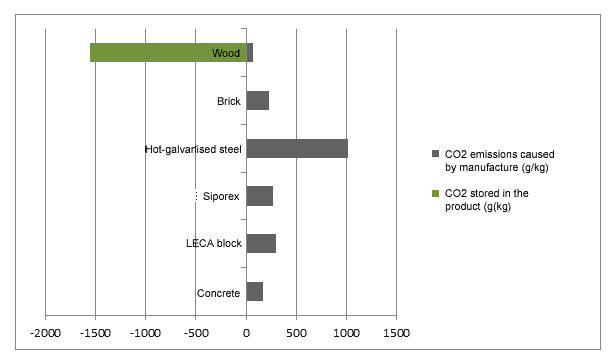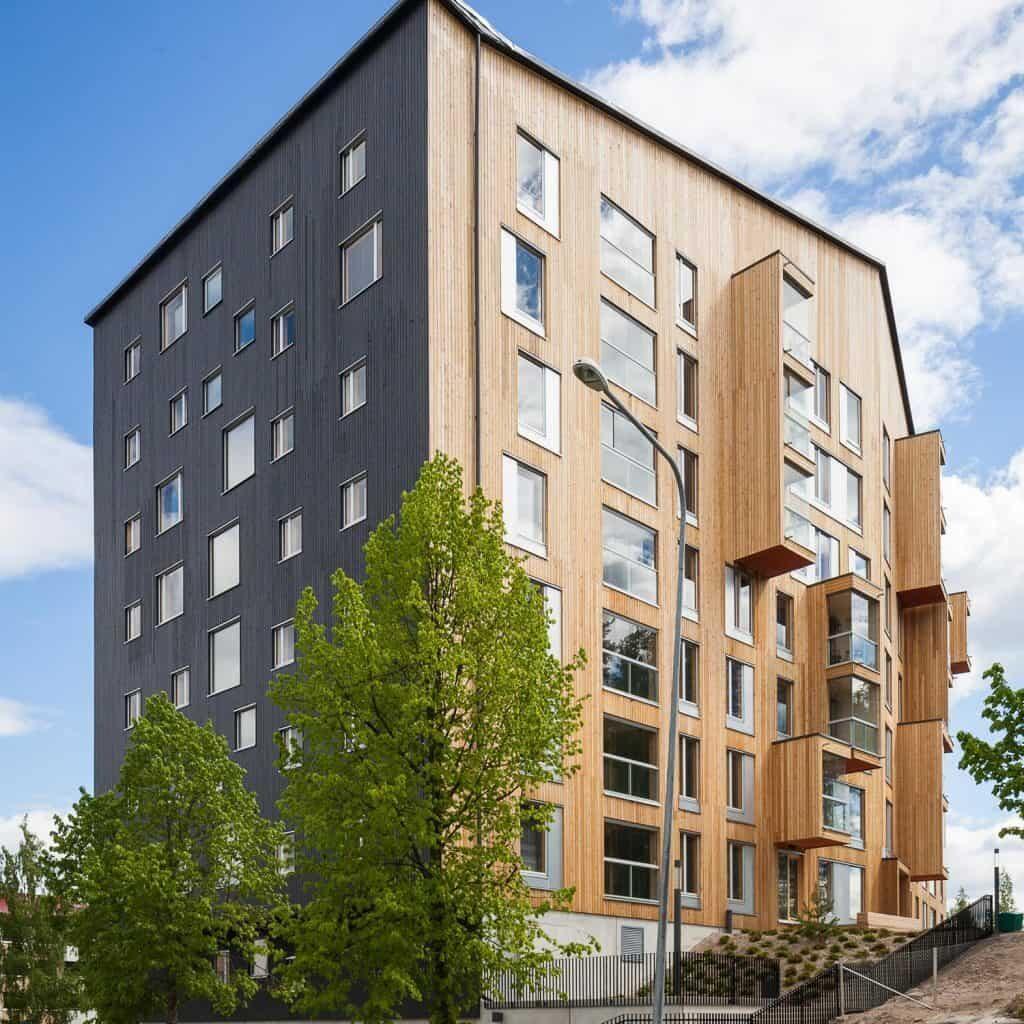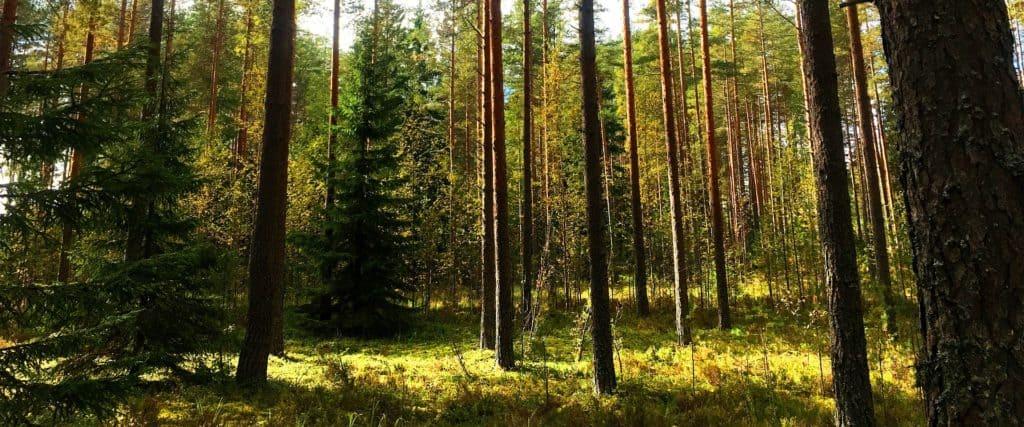The building sector accounts for 30 % of all carbon dioxide emissions. Only 5–12 % of our country's CO2 emissions come from manufacturing construction products. 90 % of emissions come from the manufacture of cement and steel.
In addition, construction is set to increase as the world's population is projected to grow to 11 billion. Therefore, construction cannot continue in the future using the same methods as today. It would produce too many emissions and would not be sustainable in any way.
Instead, building with wood is the most tangible and one of the best ways to reduce carbon emissions from construction. The CO2 emissions from wood construction are minimal compared to, for example, concrete construction. The more we replace concrete and steel with wood, the less carbon dioxide the building sector emits.
We believe that wood construction will be one of the most significant trends in the construction industry over the next decades. Construction cannot stop, but it must change.
Wood construction in Finland and abroad
Wood construction has a long tradition in Finland. The share of wood in construction in Finland is around 40%, compared to around 4% in the rest of Europe.
The use of renewable resources in both industry and consumption and finding sustainable ways of working are important for the future. We Finns have a good chance of becoming a global leader in wood construction.
"Finland is a strong country in terms of wood construction, also internationally. We have huge expertise in the whole value chain, from forestry to wood processing, wood architecture and wood construction. We are already well known around the world for our expertise in log construction, but we are equally well placed to become a major player in other wood construction."
- Petri Heino, Ministry of the Environment
Most Finnish wood construction is still focused on detached houses. In the last ten years, wood construction has also become more common in large buildings, such as wooden apartment blocks. This is a very positive trend, as there is a growing global demand for timber construction solutions.
"Wood construction requires very few imported inputs, which is great for the national economy. Wood is our national natural resource and wood construction and processing are resources that we should make more use of. Even conservative estimates put the economic value of our forests at over 60 billion. Our potential is huge, as sustainable production skills and low-carbon construction are in skyrocketing global demand."
- Petri Heino, Ministry of the Environment
The benefits of wood construction speak for themselves
1) Wood construction is ecological
If all houses in Europe were built from wood instead of concrete, carbon emissions from construction would drop by 60%. The use of non-renewable resources would be reduced by up to 70%. These are huge figures. The construction sector produces a third of all carbon dioxide emissions. The choice of materials during construction has a major impact on the environment. Wood is an ideal solution for construction, because a wooden building absorbs carbon dioxide from the atmosphere for as long as it is in use. When the building is demolished, the wood can be used for energy production (Source: Rakennustiedo RT environmental descriptions and Metsäteollisuus ry).
"Few people realise how much of our spending is in the construction sector. The more we invest in sustainable solutions in the building sector, such as wood, the more sustainable our consumption becomes. So the forestry and construction industry is a good base to change the way Finns consume to a more sustainable basis."
- Petri Heino, Ministry of the Environment
2) Wood is light and strong
A wooden building is about 80% lighter than an equivalent concrete building. Thanks to this lightness, the construction of a timber house requires less logistics, as the elements can be imported in large, prefabricated packages instead of just raw materials. Although lightweight and easy to shape, wood is an extremely strong material that will last for hundreds of years if well cared for.
3) Demolition of a wooden building generates little waste
When a concrete building is demolished, a lot of waste is generated. It is estimated that 40-50% of all waste is generated from construction and demolition. When a timber-framed house is demolished, most of the materials can be used for energy production, for example.
4) Research shows that it is good for people to be in a wooden building
Touching a tree has been studied to lower a person's stress level and heart rate, and to improve mood. This is due to the transmission of electricity, light and sound through the tree. Wood prevents resonance and wood materials can be used to support comfortable acoustics. In terms of light, wood refracts warm wavelengths of yellow and red light. This is why wood is perceived as a warm material.
The variations in stress levels also seem to be influenced by the electrical conductivity of different materials. For example, contact with aluminium, cool plastic and stainless steel at room temperature caused an increase in blood pressure as a stress response in the body. Touching a wooden surface, on the other hand, did not cause a similar reaction.
"The main advantages of wood construction are the ecological nature of the entire production chain and the naturalness of the wood. In use, wood supports human health and well-being, because people react differently to natural materials than to artificial materials. As a natural material, wood does not raise stress levels and it does not radiate like, for example, artificial concrete."
- Petri Heino, Ministry of the Environment
5) Wood construction does not require much import input
Finland has extensive expertise in forestry, wood processing, wood architecture and wood construction. Therefore, wood construction requires only minimal import inputs. Wood construction therefore employs a significant number of Finns, from forest management to maintenance work on the finished building.
The overall carbon footprint of wood construction is not zero, but negative.
The building sector is responsible for around 30% of the country's carbon dioxide emissions. Between 5% and 12% of total CO2 emissions come from the manufacture of building materials alone. 90% of that figure comes from the manufacture of steel and concrete.

However, the emissions and environmental impact of wood are minimal compared to concrete and steel. In fact, the carbon footprint of timber construction is negative, as the finished timber building absorbs carbon dioxide from the air for as long as the building exists. A single wooden house absorbs 25 000 kg of carbon dioxide. That's the same as the average car driver emits in 10 years (Source: Puuinfo).
Increasing the use of wood also has other positive effects for the climate. The more we use wood for construction, the more we want to take care of our forests and their condition. Forests play a major role in mitigating climate change because they act as carbon sinks.
Safety in a wooden building
Wood construction has a long tradition in Finland. That is why there are also many misconceptions and false beliefs about it, dating back many years. Modern timber construction is completely different from what it was only 20 years ago.
Wood is a fire-safe material
Modern wooden buildings are highly fire resistant thanks to their first-class design.
In addition, all wooden buildings over 2 storeys must have an automatic fire extinguishing system. Such a sprinkler system does not spray a jet of water but a water mist, quickly suppressing the fire. The mist does not wet structures and extends, for example, under a table, where a direct water jet would not reach.
"There are many misconceptions about the tree that are not true. Modern timber buildings have an extremely high level of fire and moisture resistance. Fire design skills have improved and buildings over two storeys should have automatic fire extinguishing systems. The sound insulation of timber buildings is also nowadays first class. I hope that the misconceptions about timber construction that have been carried over from decades will be dispelled as timber construction becomes more widespread in Finland and around the world."
- Petri Heino, Ministry of the Environment
Wood has a high moisture resistance
Wood is a naturally breathable material that resists moisture well. With good ventilation and a building that is structurally sound, there are no problems with moisture. The same applies to all other building materials.
In addition, a building made of wood is usually 80% lighter than an equivalent building made of concrete and steel. The lightness of wood allows it to be moved in large prefabricated elements. Such elements are manufactured under dry and standardised factory conditions, resulting in a consistent quality of construction and no moisture stress. The assembly of the building from prefabricated elements is fast, so that construction is not at the mercy of the weather.
Is there enough wood in our forests to build?
By the time you finish reading this sentence, our forests will have grown enough wood to build a single-family house. In turn, by this time tomorrow, our forests will have grown the annual wood requirement for the entire Finnish timber construction industry, assuming the growing season is under way.
Finland has 2.5 billion cubic metres of wood in its forests. Its forestry value is estimated at €60 billion in conservative estimates and €210 billion in the most optimistic estimates. In 2017, our forest cover grew by 107 million cubic metres per year. With a removals rate of 87 million cubic metres, our forests are growing at a fair pace, even after taking removals into account. Our tree cover has increased 1.7-fold from the 1920s to the present day. Most of the growth is in spruce and pine. (Source: Natural Resources Institute Finland)
So there is plenty of wood for construction, even if wood construction becomes more widespread. We have all the prerequisites to become one of the most important countries in the world for wood construction.
"Finnish wood is also a construction material that is sought after around the world because it is straight-grain, strong and of uniform quality. Finnish wood is also visually beautiful. In Japan, for example, it is popular to use Finnish timber pillars and beams in projects where the appearance requirements of wood are emphasised. In Central Europe and China, Finnish wood panel products and furniture are popular, which also emphasise the natural appearance of wood."
- Petri Heino, Ministry of the Environment
Construction can no longer continue on the same principles as before. As the population grows, we need more homes built in a way that does not consume as much of the environment as current building methods. Wood construction is a concrete and existing answer.
By making wise choices today, we are safeguarding our planet for future generations.
Find out more about the opportunities offered by wood construction here.




